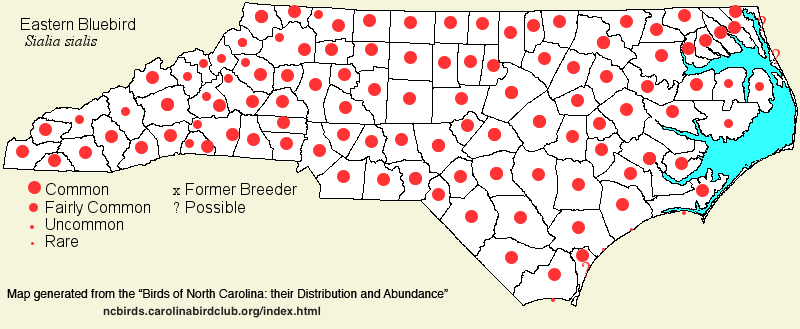 |  |
|
Eastern Bluebird - Sialia sialis TURDIDAE Members: | Search Common: Search Scientific: |
|
|
|||||||
| General Comments | No bird species in North America has benefited more by direct citizen action than has the Eastern Bluebird. This species was in decline back in the 1950's and 1960's, though it was still considered "fairly common" across its range and in much of North Carolina; for example, the bird list for Wake County in 1969 [Chat 33:53-71 link] called the species "fairly common". However, citizens have erected many thousands of bird boxes designed specifically for bluebirds, and the species has readily adapted to them, such that relatively few of the birds now nest in natural cavities such as old woodpecker holes or knotholes. Over the past few decades, we have seen quite an increase in the species, and it is now certainly "common" if not "very common" over most of the state, such that a drive in the country through farmland can easily yield 10 or more birds in a morning. It is a permanent resident in the state, with the breeding population seemingly augmented slightly by migrants from farther north; sometimes flocks of 20-30 birds are seen in the winter. Habitat in both seasons is generally fairly open country, with scattered trees or groves, and fences and phone lines for perching. This "open country" can be farmlands, but also open residential areas, as long as the area is not a forest; often occurs in open Longleaf Pine stands. In winter, bluebirds gather into small flocks, up to 20 or more birds, and often troop around farmland (plowed fields and pastures) and even open pinewoods, often with Chipping Sparrows, Pine Warblers, and other songbirds. | ||||||
| Breeding Status | Breeder | ||||||
| NC BRC List | Definitive | ||||||
| State Status | |||||||
| U.S. Status | |||||||
| State Rank | S5B,S5N | ||||||
| Global Rank | G5 | ||||||
| Coastal Plain | Permanent resident, with some migratory movements; slightly increasing. Over most of the province, common to locally very common in summer, and common to often very common in winter. However, it is scarce near the northern coast (such as forested areas on the Pamlimarle Peninsula), and it generally avoids the barrier islands, even in migration (rarely seen on Hatteras or Ocracoke islands). Peak counts: | ||||||
| Piedmont | Permanent resident, with some migratory movements; slightly increasing. Common to locally very common at all seasons, and somewhat more numerous in winter, when often very common. Peak counts: | ||||||
| Mountains | Permanent resident, with migratory movements; slightly increasing. Common over most of the region in summer, up to about 4,500 feet; scarce up to 5,500 feet. In winter, fairly common in the lower and middle elevations, and scarce to uncommon at higher elevations. (The species is less common in the mountains in winter than in summer, the reverse of the status downstate, at least in the eastern half of the state.) Peak counts: | ||||||
| Finding Tips |
None needed. **** | ||||||
| Attribution | LeGrand[2023-03-27], LeGrand[2012-09-18], LeGrand[2011-12-11] | ||||||
| NC Map Map depicts all counties with a report (transient or resident) for the species. | Click on county for list of all known species. |
| NC Breeding Season Map Map depicts assumed breeding season abundance for the species. |  |